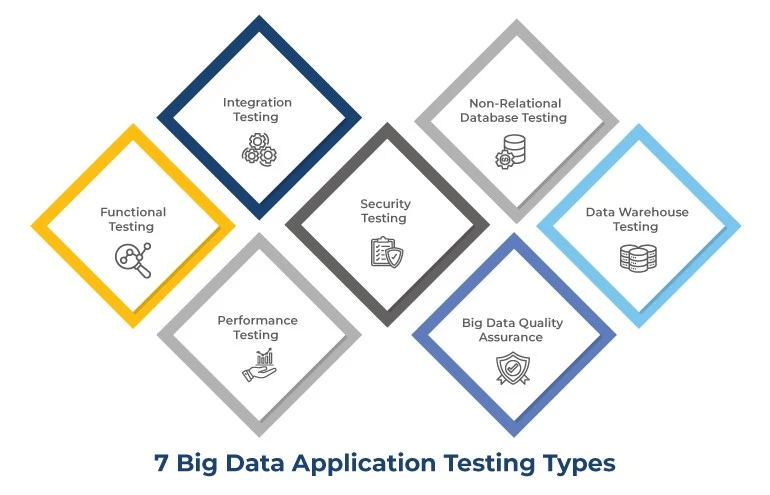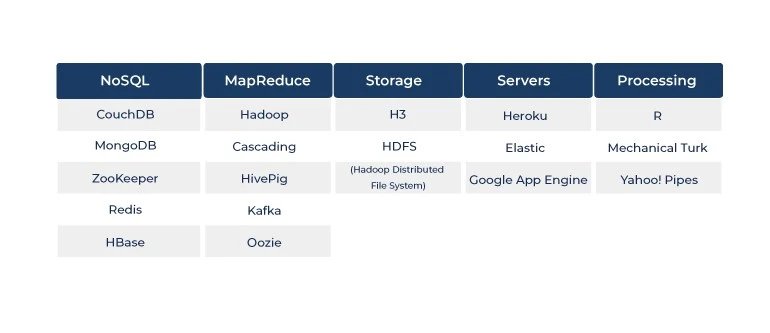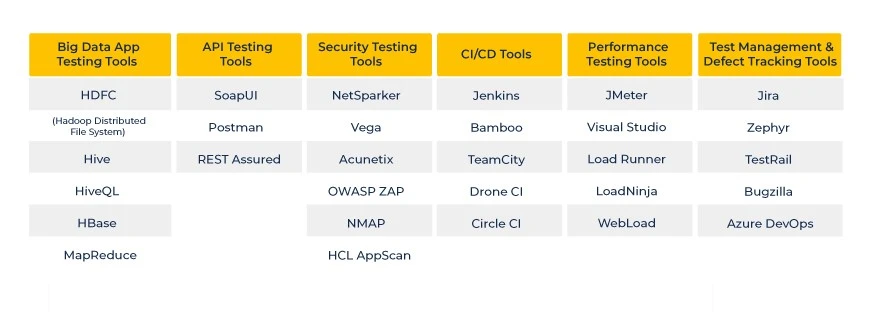Volume, velocity, and variety are considered integral when defining big data. One should also be aware of how the data will be processed at high-speed formats. To ensure the high quality of big data applications, QA engineers must be aware of the relevant testing types, processes, and strategies. This article explains everything you need to know about big data app testing and effective QA practices. It offers a comprehensive step-by-step guide to testing your big data apps and ensuring they are of the highest quality.

What are Big Data Applications?
Big data applications refer to apps that handle vast volumes of data, often measured in terabytes or more. Managing and processing such a large amount of data is naturally very time-consuming—sometimes, this handling process may take months to execute. Their testing comprises operational and analytical sides, including validation of the application’s correct and smooth functioning, resource consumption, response time, load time, data security, and data integrity.
Major Testing Types for Big Data Apps
Functional and performance testing is the primary testing types for big data applications. In big data applications, data processing and verification are more focused than the individual features and components of the application. QA engineers and testers are to ensure the smooth and successful processing of terabytes of data. This requires a high level of testing skills. Not only this, but software quality assurance engineers must also consider data quality while testing such apps. Data quality refers to data accuracy, redundancy, consistency, and completeness.
Big Data Application Testing Steps
-
Data Staging
In big data applications, data comes from different sources like weblogs, RDBMS, etc. You need to validate this data for correctness when sending it to the system. After pushing it to the system, you should compare the data with the source data to ensure it matches the latter and has been loaded to its correct respective locations.
-
MapReduce
You must validate business logic in MapReduce, a programming model designed to process and generate large datasets in parallel across distributed computing clusters. It divides tasks into two stages: the “Map” step, which transforms and sorts the data, and the “Reduce” step, which produces the aggregated results. This approach optimizes data processing for efficiency and scalability.
This step also implements data aggregation and segregation rules and ensures the generation of key-value pairs. After running the MapReduce process, you must validate the data again.
-
Output Validation
In the output validation phase, processed data is generated in files, and you can move it to the data warehouse as per your business requirements. Transformation rules and successful loading of data to the target system are also done during the output validation phase.
Other Relevant Testing Types

Here are some of the other testing types used for testing big data apps.
-
Functional Testing
Big data applications require in-depth functional testing at all levels. Ideally, you should test every functionality of a big data application separately. It is also critical that you validate outputs and application behavior on certain test inputs and data sets during the functional testing phase.
-
Integration Testing
Integration testing ensures smooth and coherent interaction of all the bid data app components with third-party applications. It also checks for the compatibility of various technologies being used. Integration testing is performed per the application’s architecture and the technology stack used.
-
Performance Testing
To ensure the stability and performance testing of a big data app, performance testers should measure the application access latency, data, processing capacity, and response and load time from multiple geographical regions, as network throughput can vary across different regions. The application stress and load-handling capacity are crucial for optimal results and customer sustainability.
-
Security Testing
A security testing engineer should validate data encryption standards, redundant parameters, role-based access controls, and application architectural issues to ensure the security of large volumes of critical and highly sensitive data. Cybersecurity professionals are encouraged to perform security, network, and penetration testing of the application.
-
Non-Relational Database Testing
Test engineers look for the queries handled by the database. It is highly recommended that database configurations and parameters be verified for the desired performance. The data backup and restore process is also essential, as it prevents data loss and makes the recovery workflow less challenging.
Designing test cases also depends on the database structures used while developing the big data application since different databases use different scripting and query languages.
-
Data Warehouse Testing
BI (business intelligence) testing is a part of data warehouse testing. It assists you in maintaining data integrity and ensuring seamless functioning of online analytical processing (OLAP) operations. It is pivotal to validate business rules and logic within the data warehouse columns and rows while testing big data apps.
-
Big Data Quality Assurance
With big data applications, it is hard to maintain complete data consistency, accuracy, and uniqueness as the application components can replicate data. Data test engineers should, however, run different tests to ensure data quality using the ETL (extract, transform, and load) process and data modeling techniques.
Getting Started with Big Data Application Testing

Big data test plans and steps can vary as per the business process, application-specific business requirements, and architecture. Based on our past experiences, we have listed some of the common abstract-level testing and quality assurance services for big data below.
-
Test Designing of Big Data Application
You should assign the big data app requirements to a QA manager during the design phase. Make sure these requirements are clear, concise, complete, and measurable. Moreover, list the functional requirements such that they can be further curated to form user stories.
A QA manager is also responsible for designing the testing KPI suites, including test case creation, execution, test coverage, identified defects, rejected and approved defects, bug leakage, and other components. Furthermore, you should initiate a risk mitigation plan to address and eliminate potential risks in big data app testing.
Similarly, you have to outline user scenarios and schedule meetings between mobile app development and testing teams so that the testing and QA engineers are better equipped with a solid understanding of the app schema. This helps ensure quality output.
-
Preparation of Big Data Application Testing
The test preparation process for big data applications can vary depending upon the sourcing model of your application testing, in-house or outsourced.
For in-house big data application testing, the QA manager should come up with a big data testing approach, big data application testing strategy, testing plan, estimates, required efforts, training of current resources, and recruitment of additional resources.
Automation testing is also recommended for big data software testing due to the huge data volume and complex architecture. It is the best approach to testing the application at a functional level, checking data quality, and evaluating application performance.
You can also opt for outsourcing if you lack in-house QA resources. Consider the following factors if you choose to outsource the testing procedure:
- Vendor experience
- Reviewing case studies
- Big data tech stack
- Testing Resources
- Operational and analytical testing teams
- Flexibility and scalability
- Cost-effectiveness
- Technical knowledge and competency of the vendor
-
Launch of Big Data Application Testing
You can launch big data application testing after setting up a testing environment and test data management system. Practically, it is not possible to fully replicate the production side of a big data application in a testing environment due to the application’s size. Therefore, consider the capacity of distributed storage and high performance to run tests at different scales.
Big Data Testing Tools
There is a wide range of tools and software for big data testing. Many automation testing tools are also used to integrate with various platforms like Teradata, Hadoop, MongoDB, AWS, etc. You also need DevOps integration to support the delivery process.

Different tools serve different purposes during various big data application scenarios.

Here are some more tools used throughout the testing process.

Challenges in Big Data Testing
-
Virtualization
The latency and loading time of virtual machines in big data testing highly impact the performance testing results of the application.
-
Size of the Dataset
Massive datasets require more testing efforts and faster verification of higher data volumes. Automation testing and cross-platform application testing are also challenges for high-volume data sets.
-
Automation Testing
To automate big data testing, high technical expertise is required. Moreover, while testing big data applications, a variety of exceptions can occur, which the automation tools cannot handle.
-
Performance-related Testing
Big data application components can belong to various technologies and testing each component in isolation can be a huge challenge. You require multiple tools to thoroughly perform the big data application testing, as single tools usually cannot test the end-to-end flows of such applications.
-
Testing Environment
You need to set up a special test environment due to the large size of the data set. Also, setting up an environment equivalent to production is not completely feasible.
Conclusion
Big data, its analytics, and subsequent utilization for data-driven decision-making are the most consequential elements of business success in a data-centric world. As companies double down on developing big data apps, testing, and software quality assurance assume even greater importance with regard to big data apps.
This article offers a comprehensive way of testing and ensuring high-quality working software through quality assurance and testing practices. Xavor offers big data testing services to companies worldwide, including startups and Fortune 500 companies.
Drop us a line at [email protected] to book a free consultation session with our Quality Assurance team.












